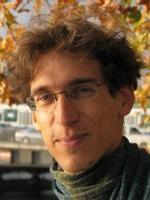Keynote Speakers
Keynote Speaker: Thomas Corpetti
Keynote Topic: Recent advances on data assimilation for the analysis of low and very high spatial resolution images: application to the monitoring of atmospheric flows and vegetation
Abstract: Data assimilation techniques, mainly used in geosciences during the past 2 decades, enable to recover a system state partially observed and submitted to a known dynamics. Such techniques have proven to be powerful, especially in the meteorological community, for the estimation of a set of variables related to the atmosphere that are most of the time directly measured using local probes (temperature, wind, ...). However, its use with spatio-temporal data like images is not easy since the relationship between the observed image luminance and the quantity of interest (motion, curve, ...) is often non-linear and uncertain. Moreover, the underlying dynamics, even if valid for a physical quantity, has to be adapted when applied to the image luminance. In this talk, after presenting the general idea of data assimilation, we will design some specific observation operators and dynamical models devoted to the assimilation of image data. The applications will especially be focused on the analysis of geophysical flows (motion estimation, curve tracking, data reconstruction), the recovery of vegetation and also on crowd analysis/synthesis.
Biography of Keynote Speaker:
 |
Thomas Corpetti's main research topic concerns image and data analysis for environmental applications. He joined LETG-Rennes COSTEL and OSUR in 2004 and between 2009 and 2012, he was in Beijing, China, working for LIAMA (Lab of Informatics, Automatics and Applied Mathematics), a lab composed of Chinese: CASIA (Chinese Academy of Sciences, Institute of Automation), Tsinghua University and European structures (INRIA, CNRS, INRA, CIRAD, Groupe des Ecoles Centrales). Since Oct. 2012, he came back to France with OSUR. |
Keynote Speaker: Konrad Schindler
Keynote Topic: Multiple object tracking by energy minimisation
Abstract: Multiple target tracking aims at reconstructing trajectories of several moving targets in a dynamic scene. The task is challenging for various reasons, including low-level problems such as lighting and image quality as well as tracking-specific problems like data association and physical plausibility across frames. I will describe different ways to formulate multi-target tracking as a single, integrated energy minimisation problem. In particular, I will present and compare in more detail a completely discrete model and optimisation scheme, a purely continuous formulation, and a mixed discrete-continuous scheme that explicitly addresses data association. Furthermore, the talk will discuss open issues of performance evaluation and comparison of tracking algorithms.
Biography of Keynote Speaker:
 |
Konrad Schindler received a Diplomingenieur (M.tech) degree in photogrammetry from Vienna University of Technology, Austria in 1999, and a PhD in computer science from Graz University of Technology, Austria, in 2003. He has worked as a photogrammetric engineer in the private industry, and held researcher positions in the Computer Graphics and Vision Department of Graz University of Technology, the Digital Perception Lab of Monash University, and the Computer Vision Lab of ETH Zurich. He became assistant professor of Image Understanding at TU Darmstadt in 2009, and since 2010 has been a tenured professor of Photogrammetry and Remote Sensing at ETH Zurich. His research interests lie in the field of computer vision, photogrammetry, and remote sensing. He currently serves as head of the Institute of Geodesy and Photogrammetry, as President of ISPRS commission III, and as associate editor for the ISPRS Journal of Photogrammetry and Remote Sensing, and for the Image and Vision Computing Journal. |